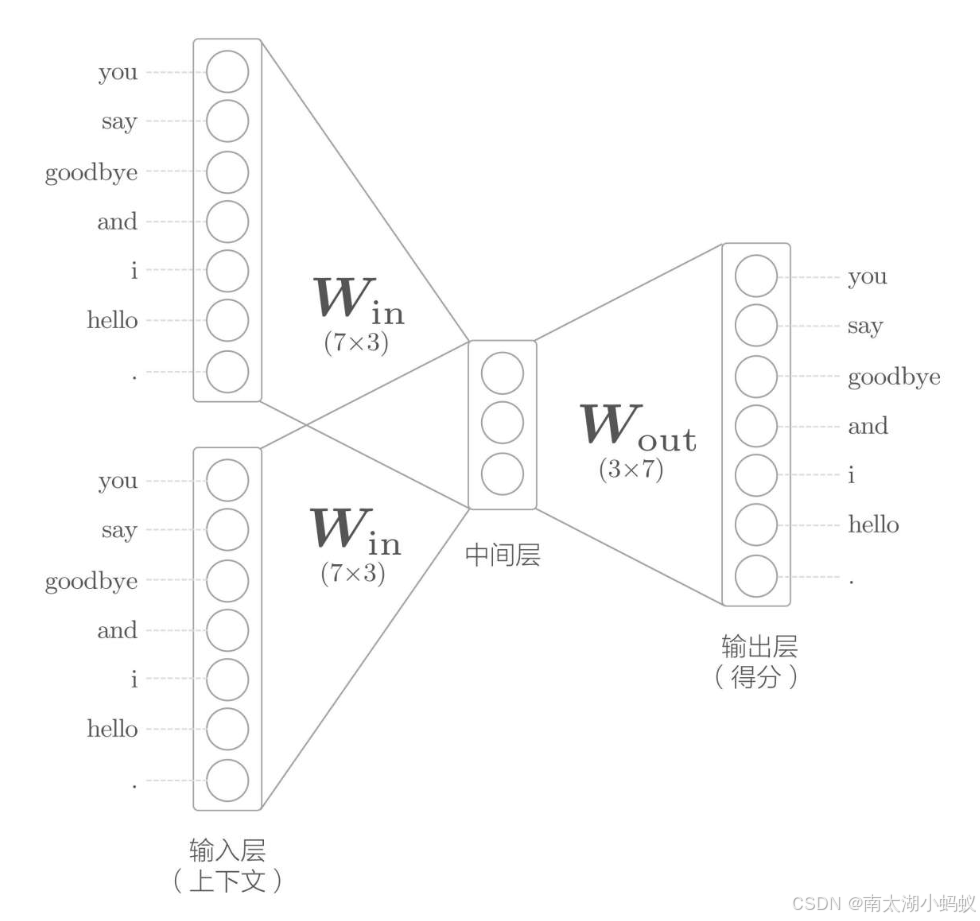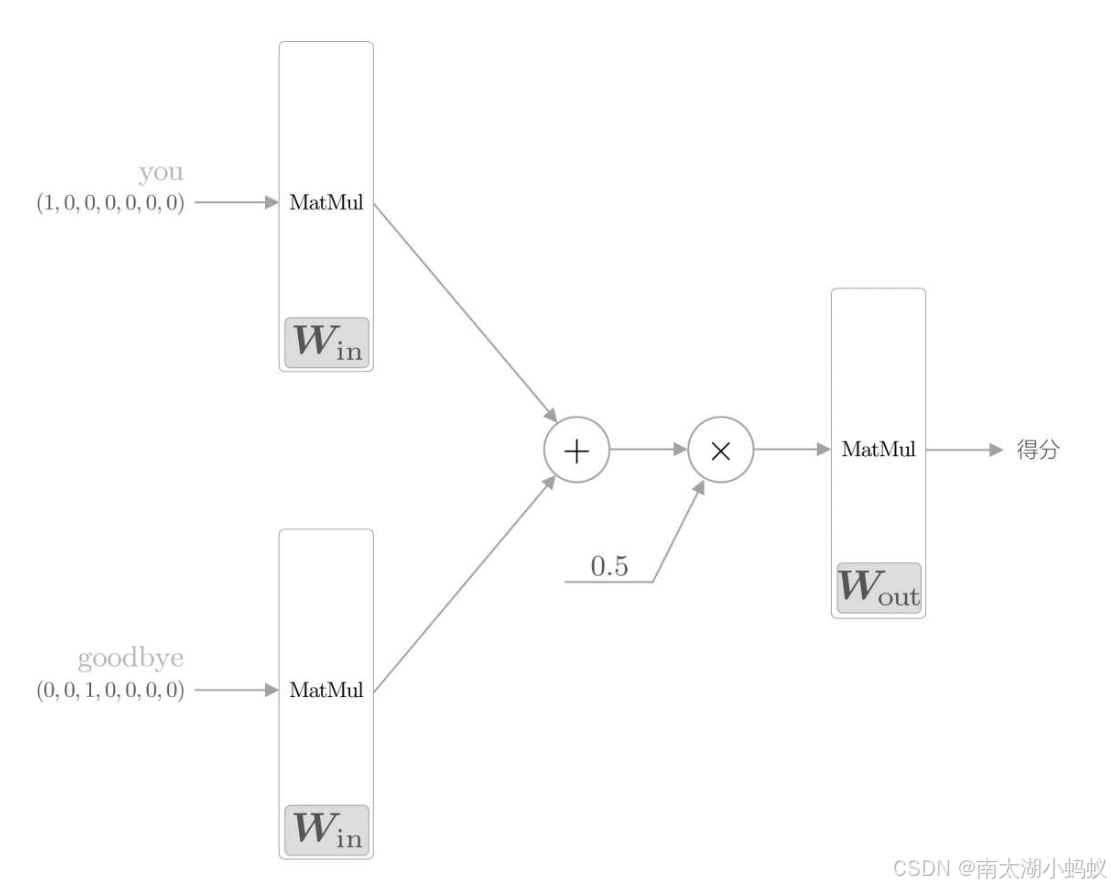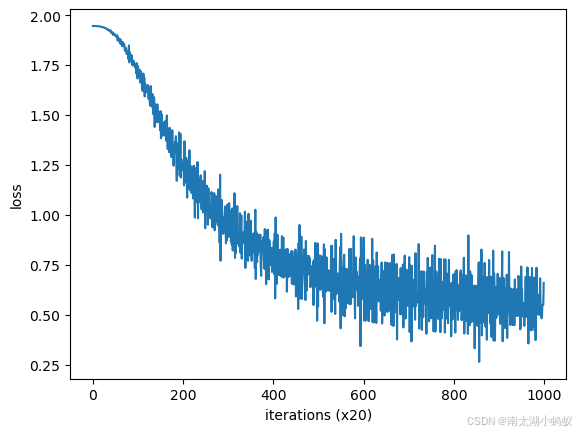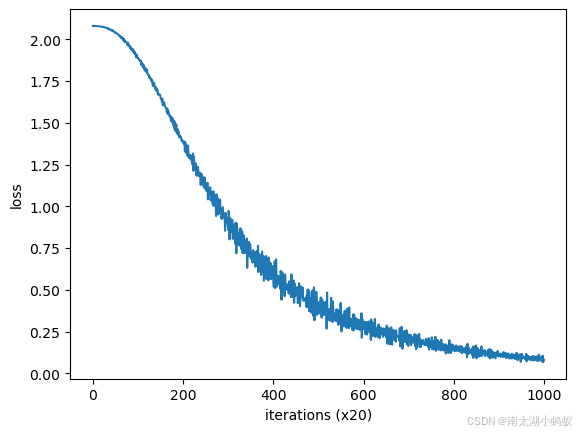一、概述
上一篇文章《自然语言处理入门1——单词的表示和距离》我们谈到了单词的表示以及距离的相似度计算,从而可以预测哪个单词的出现概率最高,这种方法被成为基于计数的方法,因为从根本上都要计算单词的出现次数,构建共现矩阵。不过这种方法有个问题,就是计算量太大,特别是现实当中的语料库都很大,一本小说可能就有几十万上百万字,构建100万x100万的共现矩阵的开销是不可接受的,特别是还要在上面做SVD计算。所以引入了神经网络,也被称作基于推理的方法。基于计数的方法需要一次性学习所有数据,而神经网络可以用小批量的数据进行部分学习,不断改进,即使语料库很大也可以进行学习。(对应《深度学习进阶:自然语言处理》的第三章)
二、CBOW模型
我们考虑一种最简单的情况,基于上下文预测出中间缺失的单词,并且仅仅预测中间缺失的一个单词,上下文也只用一个单词,如“ you ? goodbye and i say hello.”,用you和googdbye去预测问号的值。这种预测就类似于完形填空,是比较简单的一种情况。处理这种完形填空问题的一个代表模型是CBOW。CBOW是根据上下文预测目标词的神经网络,这里的目标词是指中间的单词,如例子中的问号处,上下文就是指周围的单词。通过训练这个模型,我们可以使其尽可能正确的预测出中间缺少的单词。
书中给出的CBOW的模型结构图如下:

其实就是输入待预测目标周围的两个单词作为上下文,和中间层做一个全连接,再和输出层做一个全连接得到分数。其中输入和输出都用one-hot表示法表示。下图表示的更为清晰:

流程如下:
1)将上下文输入表示成one-hot形式,随机生成一个输入权重矩阵和输出权重矩阵;
2)两个输入分别乘以输入权重矩阵,注意两个输入都乘以同一个权重矩阵;
3)把得到的两个结果相加后除以2,得到中间结果;
4)把中间结果乘以输出权重矩阵,得到分数;
5)把得分进行softmax处理,转化成概率,得到最大的预测值;
6)把预测值和目标值进行比较,求得交叉熵;
7)进行误差反向传播,更新权重矩阵;
8)重复上面的步骤,直到模型输出的值和真实值足够接近,停止。
这里,我们不断训练,调整的就是两个权重矩阵,直到用这两个权重矩阵可以准确的完成“完形填空”。这里我和书上不一样的地方在于,我的目标不是获取单词的向量表示,而且根据上下文来预测单词,所以书中模型训练后没有考虑预测的问题,我把预测部分实现了一下。下面我们具体来看程序。
三、代码实现
根据之前的流程,首先要把语料库中单词表示成one-hot形式。我们需要先构建上下文和目标单词的向量表示。
python">import numpy as nptext = 'You say goodbye and I say hello.'
corpus, word_to_id, id_to_word = preprocess(text)
print(corpus)
print(id_to_word)
# 输出:
[0 1 2 3 4 1 5 6]
{0: 'you', 1: 'say', 2: 'goodbye', 3: 'and', 4: 'i', 5: 'hello', 6: '.'}python"># 构建上下文和目标向量
def create_contexts_target(corpus, window_size=1):target = corpus[window_size:-window_size]contexts = []for idx in range(window_size, len(corpus)-window_size):#print("idx=======",idx)cs = []for t in range(-window_size, window_size+1):if t==0:continuecs.append(corpus[idx+t])contexts.append(cs)return np.array(contexts), np.array(target)contexts, target = create_contexts_target(corpus)
print(contexts)
print(target)
# 输出:
[[0 2][1 3][2 4][3 1][4 5][1 6]]
[1 2 3 4 1 5]接下来,我们用一个函数把数字表示转换成one-hot表示:
python"># 将上下文和目标词转换成one-hot表示
def convert_one_hot(corpus, vocab_size):'''转换为one-hot表示:param corpus: 单词ID列表(一维或二维的NumPy数组):param vocab_size: 词汇个数:return: one-hot表示(二维或三维的NumPy数组)'''N = corpus.shape[0]if corpus.ndim == 1:one_hot = np.zeros((N, vocab_size), dtype=np.int32)for idx, word_id in enumerate(corpus):one_hot[idx, word_id] = 1elif corpus.ndim == 2:C = corpus.shape[1]one_hot = np.zeros((N, C, vocab_size), dtype=np.int32)for idx_0, word_ids in enumerate(corpus):for idx_1, word_id in enumerate(word_ids):one_hot[idx_0, idx_1, word_id] = 1return one_hotvocab_size = len(word_to_id)
target = convert_one_hot(target, vocab_size)
contexts = convert_one_hot(contexts, vocab_size)
print(target)
print(contexts)
# 输出:
[[0 1 0 0 0 0 0][0 0 1 0 0 0 0][0 0 0 1 0 0 0][0 0 0 0 1 0 0][0 1 0 0 0 0 0][0 0 0 0 0 1 0]]
[[[1 0 0 0 0 0 0][0 0 1 0 0 0 0]][[0 1 0 0 0 0 0][0 0 0 1 0 0 0]][[0 0 1 0 0 0 0][0 0 0 0 1 0 0]][[0 0 0 1 0 0 0][0 1 0 0 0 0 0]][[0 0 0 0 1 0 0][0 0 0 0 0 1 0]][[0 1 0 0 0 0 0][0 0 0 0 0 0 1]]]可以看到,我们把词向量都表示成了one-hot格式的数据。接下来,我们定义模型。
python"># 矩阵乘法模块
class MatMul:def __init__(self, W):self.params = [W]self.grads = [np.zeros_like(W)]self.x = Nonedef forward(self, x):W, = self.paramsout = np.dot(x, W)self.x = xreturn outdef backward(self, dout):W, = self.paramsdx = np.dot(dout, W.T)dW = np.dot(self.x.T, dout)self.grads[0][...] = dWreturn dx# 实现CBOW类
class SimpleCBOW:def __init__(self, vocab_size, hidden_size):V,H = vocab_size, hidden_size# 初始化权重W_in = 0.01*np.random.randn(V,H).astype('f')W_out = 0.01*np.random.randn(H,V).astype('f')# 生成层self.in_layer0 = MatMul(W_in)self.in_layer1 = MatMul(W_in)self.out_layer = MatMul(W_out)self.loss_layer = SoftmaxWithLoss()layers = [self.in_layer0,self.in_layer1,self.out_layer]self.params, self.grads = [], []for layer in layers:self.params += layer.paramsself.grads += layer.gradsdef forward(self, contexts, target):print("contexts[:,0].shape: ",contexts[:,0].shape)h0 = self.in_layer0.forward(contexts[:,0])h1 = self.in_layer1.forward(contexts[:,1])h = (h0 + h1) * 0.5score = self.out_layer.forward(h)loss = self.loss_layer.forward(score, target)return lossdef backward(self, dout=1):ds = self.loss_layer.backward(dout)da = self.out_layer.backward(ds)da *= 0.5self.in_layer0.backward(da)self.in_layer1.backward(da)return Nonedef get_params(self): # 获取各层训练后的参数return self.in_layer0,self.in_layer1,self.out_layer下面我们再定义一个训练函数:
python">import numpy
import time
import matplotlib.pyplot as plt
class Trainer:def __init__(self, model, optimizer):self.model = modelself.optimizer = optimizerself.loss_list = []self.eval_interval = Noneself.current_epoch = 0def fit(self, x, t, max_epoch=10, batch_size=32, max_grad=None, eval_interval=20):print("x.shape: ",x.shape)data_size = len(x)print("data_size: ",data_size)max_iters = data_size // batch_sizeprint("max_iters: ",max_iters)self.eval_interval = eval_intervalmodel, optimizer = self.model, self.optimizertotal_loss = 0loss_count = 0start_time = time.time()for epoch in range(max_epoch):# 打乱idx = numpy.random.permutation(numpy.arange(data_size))x = x[idx]t = t[idx]print("x.shape:+++++++++", x.shape)for iters in range(max_iters):batch_x = x[iters*batch_size:(iters+1)*batch_size]batch_t = t[iters*batch_size:(iters+1)*batch_size]print("batch_x.shape: ",batch_x.shape)# 计算梯度,更新参数loss = model.forward(batch_x, batch_t)model.backward()# 将共享的权重整合为1个params, grads = remove_duplicate(model.params, model.grads) if max_grad is not None:clip_grads(grads, max_grad)optimizer.update(params, grads)total_loss += lossloss_count += 1# 评价if (eval_interval is not None) and (iters % eval_interval) == 0:avg_loss = total_loss / loss_countelapsed_time = time.time() - start_timeprint('| epoch %d | iter %d / %d | time %d[s] | loss %.2f'% (self.current_epoch + 1, iters + 1, max_iters, elapsed_time, avg_loss))self.loss_list.append(float(avg_loss))total_loss, loss_count = 0, 0self.current_epoch += 1# 画出训练过程中损失值的变化def plot(self, ylim=None):x = numpy.arange(len(self.loss_list))if ylim is not None:plt.ylim(*ylim)plt.plot(x, self.loss_list, label='train')plt.xlabel('iterations (x' + str(self.eval_interval) + ')')plt.ylabel('loss')plt.show()我们用书中给出的一句话来进行测试这个模型:
python"># 训练
window_size = 1
hidden_size = 5
batch_size = 3
max_epoch = 1000
text = 'You say goodbye and I say hello.'
corpus, word_to_id, id_to_word = preprocess(text)
contexts, target = create_contexts_target(corpus)
vocab_size = len(word_to_id)
target = convert_one_hot(target, vocab_size)
contexts = convert_one_hot(contexts, vocab_size)
print("contexts.shape: ",contexts.shape)model = SimpleCBOW(vocab_size, hidden_size)
optimizer = Adam()
trainer = Trainer(model, optimizer)
trainer.fit(contexts, target, max_epoch, batch_size)
trainer.plot()
# 输出:
contexts.shape: (6, 2, 7)
x.shape: (6, 2, 7)
data_size: 6
max_iters: 2
x.shape:+++++++++ (6, 2, 7)
batch_x.shape: (3, 2, 7)
contexts[:,0].shape: (3, 7)
| epoch 1 | iter 1 / 2 | time 0[s] | loss 1.95
... ...训练过程如下:

可以看到,随着训练步骤的不断迭代,损失值不断下降。我们可以获取训练后模型的权重值,根据权重值就可以进行预测了。
这里我们使用的语料库是一句话,这句话有8个单词,词向量是7个,上下文一共有六个,分别是(you,goodbye),(say,and),(goodbye,I),(and,say),(I,hello),(say,.)6种情况,每个单词进行one-hot表示后,变成(1,7)向量,每个上下文是(2,7)向量,总体的文本库大小是(6,2,7),所以contexts.shape是(6,2,7),又由于batch_size是3,所以模型训练的时候,输入contexts是[3,2,7],其中3是batch_size,2是前后两个上下文向量,7是词表大小。contexts[:,0]和contexts[:,1]是分别指一前一后两个上下文向量,每一个的大小都是[3,7],之所以是[3,7]不是[1,7]是因为有三个向量同时输入作批处理。
python">in_layer0,in_layer1,out_layer = model.get_params()
vocab_size = len(word_to_id)
context1 = convert_one_hot(np.array([word_to_id['you']]), vocab_size)
context2 = convert_one_hot(np.array([word_to_id['goodbye']]), vocab_size)
print(context1.shape)
h0 = in_layer0.forward(context1)
h1 = in_layer1.forward(context2)
h = (h0+h1)*0.5
o = out_layer.forward(h)
print(o)
print(np.argmax(o))
# 输出:
(1, 7)
[[-0.85405053 3.98822799 -4.11465032 2.95836502 -4.12735609 -0.4473659-0.8498025 ]]
1可以看到,根据you和goodbye作为上下文,预测出的单词序号是1,从word_to_id中,我们可以发现id为1的单词是say,跟我们的原文是一致的,说明训练是有用的。
下面,我们用中文来试试,和上一篇文章一样,用“小明今天去银泰双子楼看电影了”这句话作为语料库,在数据处理中,主要的区别就在于对中文语句要做一个分词从而得到单词,不能像英语一样直接切分,因为汉字的语义最小单位是词,而不是单个字。
python">import jieba
def preprocess(text):seg_list = jieba.cut(text)words = list(seg_list)word_to_id = {}id_to_word = {}for word in words:if word not in word_to_id:new_id = len(word_to_id)word_to_id[word] = new_idid_to_word[new_id] = wordcorpus = [word_to_id[w] for w in words]corpus = np.array(corpus)return corpus, word_to_id, id_to_word# 训练
window_size = 1
hidden_size = 5
batch_size = 3
max_epoch = 1000
text = '小明今天去银泰双子楼看电影了'
corpus, word_to_id, id_to_word = preprocess(text)
contexts, target = create_contexts_target(corpus)
vocab_size = len(word_to_id)
target = convert_one_hot(target, vocab_size)
contexts = convert_one_hot(contexts, vocab_size)
print("contexts.shape: ",contexts.shape)model = SimpleCBOW(vocab_size, hidden_size)
optimizer = Adam()
trainer = Trainer(model, optimizer)
trainer.fit(contexts, target, max_epoch, batch_size)
trainer.plot()
貌似中文的训练曲线还更平滑些:)下面我们也预测一下问号中的单词,“小明今天去银泰双子楼看?了”
python">print(word_to_id)
in_layer0,in_layer1,out_layer = model.get_params()
context1 = convert_one_hot(np.array([word_to_id['看']]), vocab_size)
context2 = convert_one_hot(np.array([word_to_id['了']]), vocab_size)h0 = in_layer0.forward(context1)
h1 = in_layer1.forward(context2)
h = (h0+h1)*0.5
o = out_layer.forward(h)
print(o)
print(np.argmax(o))
# 输出:
{'小明': 0, '今天': 1, '去': 2, '银泰': 3, '双子楼': 4, '看': 5, '电影': 6, '了': 7}
[[-1.63206317 -1.45593816 -2.25134312 -2.94733467 2.15194596 0.806690995.38870997 -1.62672302]]
6根据输出,我们可以看到id为6的单词就是“电影”,也就是说这个完形填空做对了。这就是最简单的自然语言处理神经网络模型CBOW。




